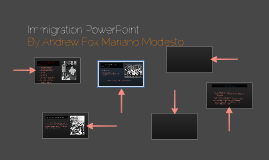immigration powerpoint
Transcript: Queens Some of the groups that influenced the cuisine brought to America include the following: Spanish Americans and early modern Spanish cuisine, as well as Basque-Americans and Basque cuisine. Early German-American or Pennsylvania Dutch and Pennsylvania Dutch cuisine French Americans and their "New World" regional identities such as: Acadian Cajun cuisine and Louisiana Creole cuisine. Louisiana Creole refers to native born people of the New Orleans area who are descended from the Colonial French and Spanish settlers of Colonial French Louisiana, before it became part of the United States in 1803 with the Louisiana Purchase. Brooklyn Bagel and lox Challah Matzo ball soup celery soda New York-style pastrami brisket corned beef tongue knish New York-style bagels and lox cream cheese A&P Serendipity 3 Junior's – The World's Most Famous Cheesecake Katz's Deli Second Avenue Deli Lindy's AriZona Beverage Company Balducci's Benihana Blimpie C-Town Supermarkets Carnegie Deli Clinton St. Baking Company & Restaurant Dean & DeLuca Dr. Brown's – sodas Entenmann's Fairway Market Food Network – the cable TV channel Fraunces Tavern Immigration is leading to an increase in the number of Buddhists, Hindus and Muslims in the United States, but a large majority of new immigrants are Christian. This stands in contrast to the situation in Europe, where a much higher percentage of immigrants are non-Christian. Early ethnic influences NYC Eastern European Jewish Cuisine The End How has immigration affected the variety of cultural foods found in New York City ? While the earliest cuisine of the United States was influenced by indigenous Native Americans, the cuisine of the thirteen colonies, the overall culture of the nation, its food and the growing culinary arts became more influenced by its changing ethnic mix and immigrant patterns from the 18th and 19th centuries to the present. Some of the ethnic groups that influenced the cuisine were here in prior years; while others arrived during “The Great Transatlantic Migration in 1870—1914 and other mass migrations. Irish Americans - Irish cuisine Italian Americans - Italian-American cuisine German Americans - German cuisine (the Pennsylvania Dutch arrived earlier than the bulk of German migrants and have distinct culinary traditions) Scottish Americans - Scottish cuisine Greek Americans - Greek cuisine, Mediterranean cuisine Portuguese Americans - Portuguese cuisine Romanian Americans - Romanian cuisine Polish Americans - Polish cuisine, with particular impact on Midwest Russian Americans - Russian cuisine, with particular impact on Midwest Lithuanian Americans - Lithuanian cuisine, with particular impact on Midwest American Jews - Jewish cuisine Indian Americans - Indian cuisine Pakistani Americans - Pakistani cuisine Japanese Americans - Japanese cuisine, with influences on the Hawaiian cuisine Polynesian Americans - Hawaiian cuisine West Indian Americans - Caribbean cuisine, Jamaican cuisine Cuban Americans - Cuban cuisine Chinese Americans - American Chinese cuisine, Chinese cuisine Vietnamese Americans - Vietnamese cuisine Arab Americans, particularly Lebanese Americans - Arab cuisine, Lebanese cuisine Lower East Side – Puerto Rican, Kosher and Latin American Chinatown – Chinese and Vietnamese East Harlem – Puerto Rican, Mexican, Dominican and Italian along Pleasant Avenue East Village – Japanese, Korean, Indian and Ukrainian Harlem – African-American, Latin American, West Indian, and West African Koreatown – Korean Little Italy – Italian and Chinese Murray Hill – Indian, Pakistani and Bangladeshi Washington Heights – Dominican, Puerto Rican and Jewish Upper East Side – German, Czech, Hungarian Immigration Notable food and beverage companies based in New York Bedford Park – Mexican, Puerto Rican, Dominican, Korean (on 204th St.) Belmont – Italian, Albanian (also known as "Arthur Avenue," "Little Italy") City Island – Italian, Seafood Morris Park – Italian Norwood – Filipino (formerly Irish) Riverdale – Kosher South Bronx – Puerto Rican, Dominican Wakefield – Jamaican, West Indian Woodlawn – Irish ANNOTATED BIBLIOGRAPHY African-Americans - “Soul food.” Cuisine of Puerto Rico Mexican-Americans and Mexican-American cuisine; Tex-Mex ( Texas and Mexican fusion) and Cal-Mex ( California and Mexican fusion) include some aspects of “Southwestern cuisine.” Cuisine of New Mexico British-Americans and on-going developments in New England founded the cuisine of the thirteen colonies and some aspects of other regional cuisines. Reuben sandwich Steak Diane Vichyssoise Waldorf salad Baked pretzels Italian Ice Knish Eggs Benedict Ice Cream Cone Lobster Newberg Waldorf Salad Doughnut Delmonico steak Black and white cookie Because many immigrants came to America with different religions, many of the dishes that are made by Jewish and Muslim immigrants have certain specifications and rules that need to be followed in the preparation of the food. SAYWACK, PRIAM. Immigration in New York City

















